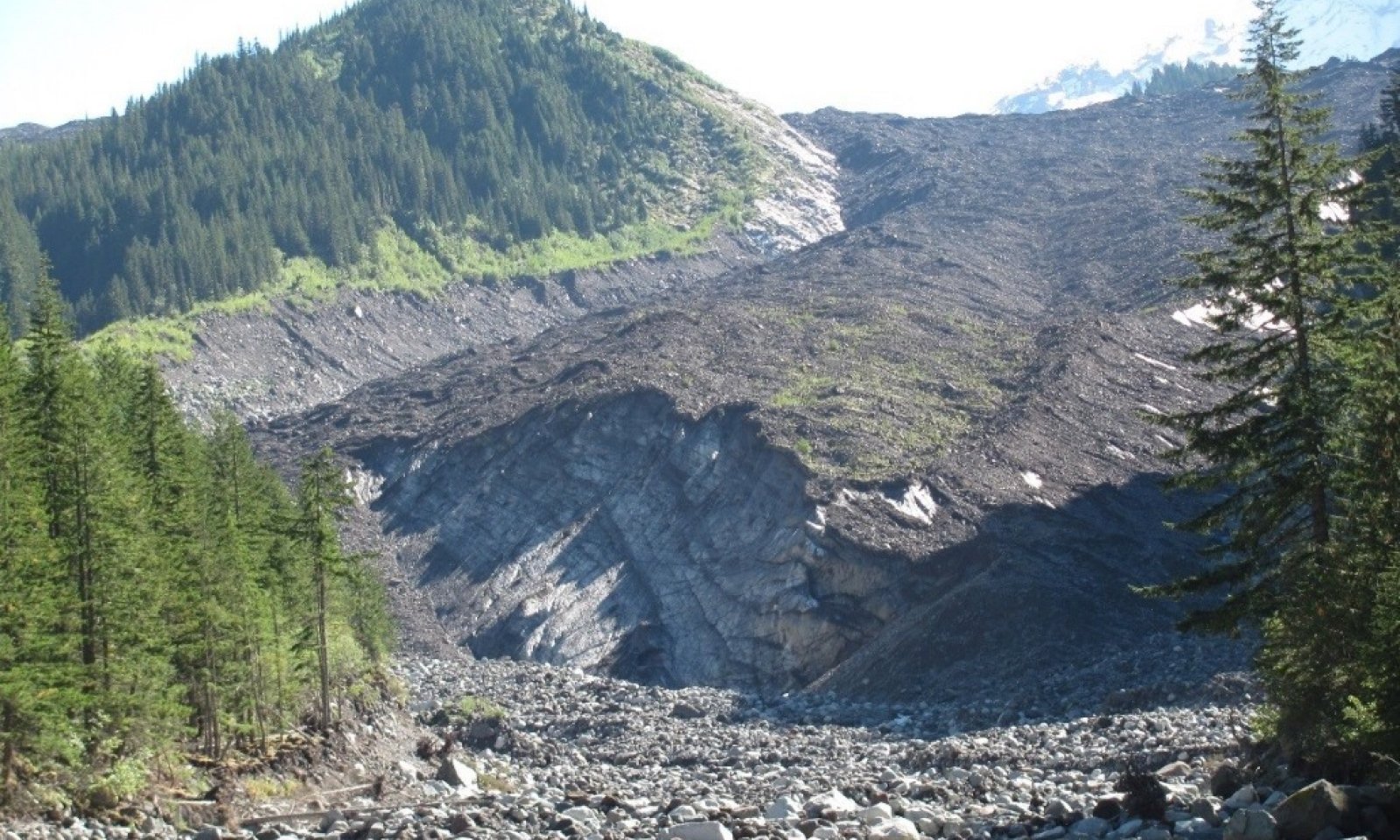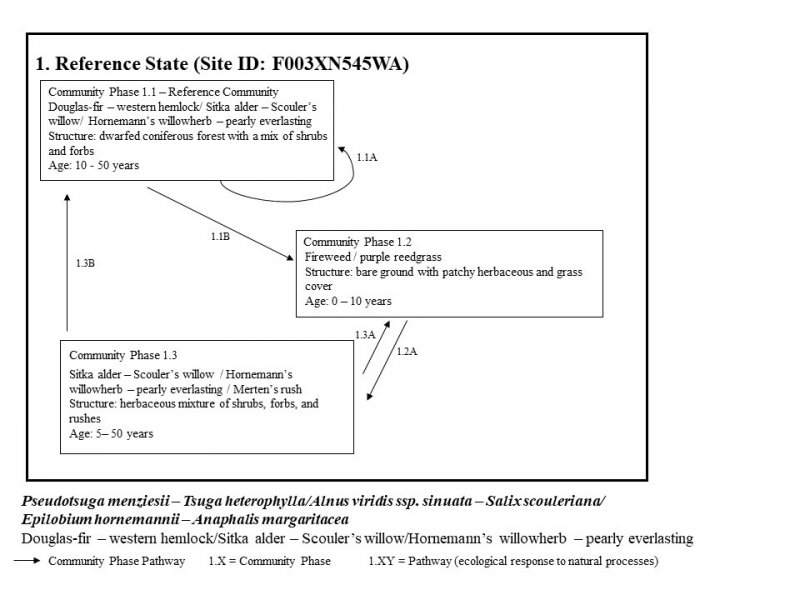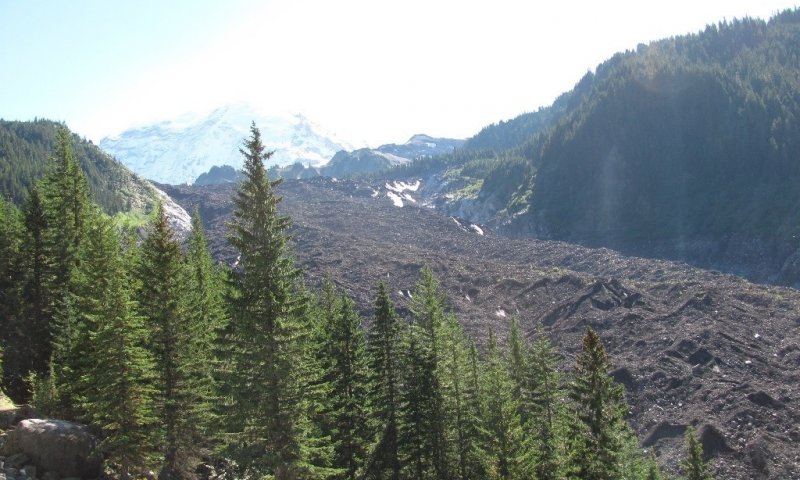

Natural Resources
Conservation Service
Ecological site R003XN545WA
Southern Washington Cascades Debris Covered Glaciers
Last updated: 1/29/2025
Accessed: 12/21/2025
General information
Provisional. A provisional ecological site description has undergone quality control and quality assurance review. It contains a working state and transition model and enough information to identify the ecological site.
MLRA notes
Major Land Resource Area (MLRA): 003X–Olympic and Cascade Mountains
Steep mountains and narrow to broad, gently sloping valleys characterize this MLRA. A triple junction of two oceanic plates and one continental plate is directly offshore from Puget Sound. Subduction of the oceanic plates under the westerly and northwesterly moving continental plate contributes to volcanic activity in the Cascade Mountains. Movement among these plates has resulted in major earthquakes and the formation of large stratovolcanoes. The Cascade Mountains consist primarily of volcanic crystalline rock and some associated metasedimentary rock. The mean annual precipitation is dominantly 60 to 100 inches, but it is 30 to 60 inches on the east side of the Cascade Mountains.
The soil orders in this MLRA are dominantly Andisols, Spodosols, and Inceptisols and minor areas of Entisols and Histosols. The soils are dominantly in the frigid or cryic temperature regime and the udic moisture regime. The soils generally are shallow to very deep, well drained, ashy to medial, and loamy or sandy. They are on mountain slopes and ridges.
Ecological site concept
This ecological site is on debris-covered termini of alpine glaciers at an elevation of 3,600 to 7,200 feet. Several large glaciers carved steep-sided valleys on Mount Rainier, and the valley walls formed in old moraines that consist of loose andesitic till. Gravity causes the loose till to move downslope onto the termini of the alpine glaciers. Other sources of debris include rockfalls; material released as a result of freezing and thawing, which impacts the availability of water; and waterborne and windborne sediment.
The soils that support this ecological site are in the gelic soil temperature regime and the udic soil moisture regime. They are coarse textured and very low in content of organic matter and have a low cation-exchange capacity. They are about 20 inches deep to permafrost. Because of the permafrost, the subsurface soil temperature is much cooler than that of other soils at similar elevations. Variations in the depth of the soils favor growth of species in early seral communities. The species are highly variable.
The forests and other habitats surrounding the glaciers provide an adequate seed source, which influences the biological diversity of the site. The early seral species become established in the limited debris cover and are affected by frequent disturbances (Fickert, 2007).
The length of the growing season is dependent on factors such as the duration of snow cover, soil temperature, and soil moisture. Areas on south-facing slopes support more drought-sensitive species, such as pearly everlasting and stonecrop (Sedum), and areas on north-facing slopes support species such as purple monkeyflower (Mimulus lewisii) and Mertens’ rush (Juncus mertensianus) (Fickert, 2007). Elevation is not a primary factor affecting the dynamics of the site.
Associated sites
| F003XN952WA |
Southern Washington Cascades High Cryic Deciduous Forest Ecological site R003XN545WA, Southern Washington Cascades Debris-covered Glaciers, share some features to those of site F003XN952WA, Southern Washington Cascades High Cryic Deciduous Forest. Both ecological sites are at high elevations that are subject to extreme disturbance regimes. Both sites are colonized with early seral species that are adapted to the high elevations and poor growing conditions. Ecological site R003XN545WA is uniquely distinguished by glacial conditions and permafrost. Under warmer conditions and glacier retreat, site R003XN545WA may transition to resemble site F003XN952WA. |
|---|
Similar sites
| F003XN951WA |
Southern Washington Cascades High Cryic Coniferous Forest Over a long period without disturbance, site R003XN545WA, Southern Washington Cascades Debris-covered Glaciers, may transition to a mature forest that resembles that of site F003XN951WA, Southern Washington Cascades High Cryic Coniferous Forest. |
|---|
Table 1. Dominant plant species
| Tree |
(1) Pseudotsuga menziesii |
|---|---|
| Shrub |
(1) Alnus viridis ssp. sinuata |
| Herbaceous |
(1) Epilobium hornemannii |
Click on box and path labels to scroll to the respective text.


